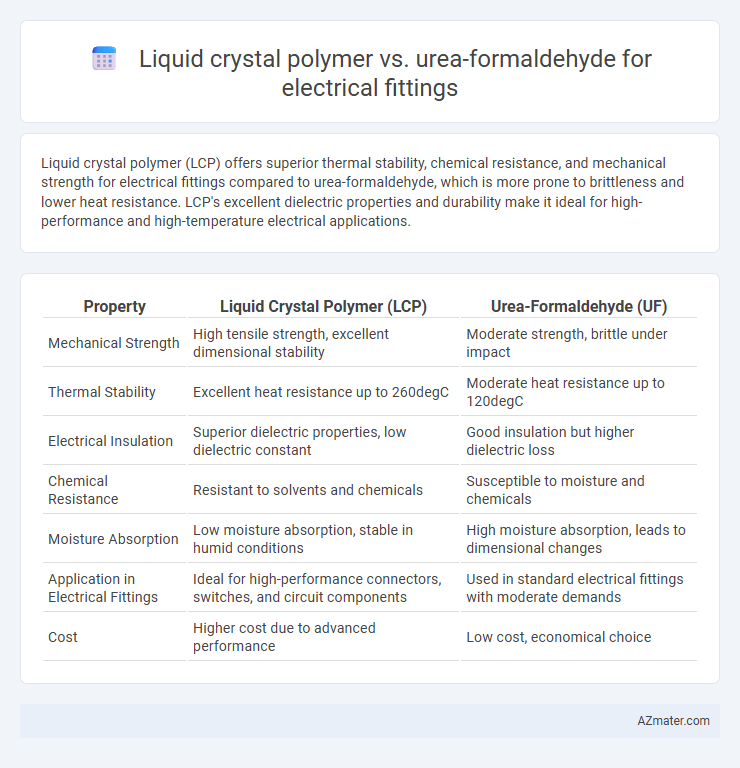Liquid crystal polymer (LCP) offers superior thermal stability, chemical resistance, and mechanical strength for electrical fittings compared to urea-formaldehyde, which is more prone to brittleness and lower heat resistance. LCP's excellent dielectric properties and durability make it ideal for high-performance and high-temperature electrical applications.
Table of Comparison
| Property | Liquid Crystal Polymer (LCP) | Urea-Formaldehyde (UF) |
|---|---|---|
| Mechanical Strength | High tensile strength, excellent dimensional stability | Moderate strength, brittle under impact |
| Thermal Stability | Excellent heat resistance up to 260degC | Moderate heat resistance up to 120degC |
| Electrical Insulation | Superior dielectric properties, low dielectric constant | Good insulation but higher dielectric loss |
| Chemical Resistance | Resistant to solvents and chemicals | Susceptible to moisture and chemicals |
| Moisture Absorption | Low moisture absorption, stable in humid conditions | High moisture absorption, leads to dimensional changes |
| Application in Electrical Fittings | Ideal for high-performance connectors, switches, and circuit components | Used in standard electrical fittings with moderate demands |
| Cost | Higher cost due to advanced performance | Low cost, economical choice |
Introduction to Electrical Fitting Materials
Liquid crystal polymer (LCP) and urea-formaldehyde are prominent materials in electrical fitting due to their distinct properties. LCP offers high thermal stability, excellent dimensional accuracy, and superior chemical resistance, making it ideal for high-performance connectors and components. Urea-formaldehyde, known for its strong insulating properties and cost-effectiveness, is commonly used in traditional electrical fittings but lacks the advanced mechanical and thermal characteristics of LCP.
Overview of Liquid Crystal Polymer (LCP)
Liquid Crystal Polymer (LCP) is a high-performance thermoplastic known for its excellent mechanical strength, chemical resistance, and dimensional stability, making it ideal for electrical fittings that require durability and precision. Compared to Urea-formaldehyde, LCP offers superior thermal resistance with a melting point above 280degC, enabling better performance in high-temperature environments without degradation. Its low moisture absorption and inherent flame retardancy further enhance electrical insulation and safety in demanding applications.
Overview of Urea-Formaldehyde (UF)
Urea-formaldehyde (UF) is a thermosetting resin widely used in electrical fittings due to its excellent insulating properties, high mechanical strength, and cost-effectiveness. It offers strong resistance to heat, moisture, and electrical stress, making it suitable for components such as switches, sockets, and circuit breakers. However, UF tends to be brittle compared to liquid crystal polymer (LCP), which limits its application in high-performance scenarios requiring enhanced durability and flexibility.
Mechanical Properties: LCP vs UF
Liquid crystal polymer (LCP) exhibits superior mechanical properties compared to urea-formaldehyde (UF) in electrical fittings, including higher tensile strength and exceptional dimensional stability under thermal stress. LCP materials demonstrate enhanced impact resistance and flexibility, reducing the risk of cracking or deformation during assembly and operation. UF, while cost-effective and electrically insulating, tends to be more brittle and less resistant to mechanical stresses, limiting its application in high-performance electrical components.
Electrical Insulation Performance Comparison
Liquid crystal polymer (LCP) offers superior electrical insulation performance compared to urea-formaldehyde due to its high dielectric strength and low dielectric constant, which minimize electrical losses and enhance signal integrity. LCP's excellent resistance to thermal and electrical stress ensures consistent insulation in high-frequency and high-temperature applications, outperforming the relatively brittle and moisture-sensitive urea-formaldehyde resin. This makes LCP a preferred material for advanced electrical fittings requiring reliable insulation properties and long-term durability.
Thermal Stability and Heat Resistance
Liquid crystal polymers (LCPs) exhibit superior thermal stability and heat resistance compared to urea-formaldehyde, maintaining mechanical strength and dimensional stability at temperatures exceeding 250degC. Urea-formaldehyde, while cost-effective and widely used, typically degrades and loses insulation properties at temperatures above 120-150degC, limiting its application in high-heat electrical fittings. The high melting point and low thermal expansion of LCPs make them ideal for electrical components requiring reliable performance under sustained thermal stress.
Chemical Resistance: LCP and UF
Liquid crystal polymer (LCP) exhibits superior chemical resistance compared to urea-formaldehyde (UF), especially against solvents, acids, and bases commonly encountered in electrical fitting environments. While LCP maintains structural integrity and performance under exposure to harsh chemicals, urea-formaldehyde tends to degrade, showing brittleness and loss of mechanical properties. This chemical resistance makes LCP a more durable and reliable material choice for electrical fittings in demanding industrial applications.
Durability and Lifespan in Electrical Applications
Liquid crystal polymer (LCP) exhibits superior durability and an extended lifespan in electrical fittings due to its high heat resistance, exceptional mechanical strength, and low moisture absorption compared to urea-formaldehyde (UF). Urea-formaldehyde tends to degrade faster under thermal stress and exposure to moisture, leading to brittleness and reduced electrical insulating properties over time. LCP's robustness in harsh electrical environments makes it ideal for long-lasting, high-performance electrical components.
Environmental Impact and Safety Considerations
Liquid crystal polymer (LCP) offers superior environmental benefits over urea-formaldehyde (UF) in electrical fittings due to its recyclable nature and resistance to chemical degradation, reducing hazardous waste generation. Urea-formaldehyde releases formaldehyde gas during manufacturing and disposal, posing significant health hazards such as respiratory issues and carcinogenic risks. Safety considerations prioritize LCP for its thermal stability and low toxicity, which contribute to safer installation and long-term use in electrical components.
Cost Efficiency and Application Suitability
Liquid crystal polymer (LCP) offers superior electrical insulation and thermal stability compared to urea-formaldehyde, making it ideal for high-performance electrical fittings in demanding environments. Urea-formaldehyde is significantly more cost-effective and widely used for standard electrical fittings due to its affordable production and adequate insulating properties. The choice between LCP and urea-formaldehyde depends on balancing the higher upfront cost of LCP with its enhanced durability and application suitability against the budget-friendly, but less robust, nature of urea-formaldehyde.

Infographic: Liquid crystal polymer vs Urea-formaldehyde for Electrical fitting
 azmater.com
azmater.com